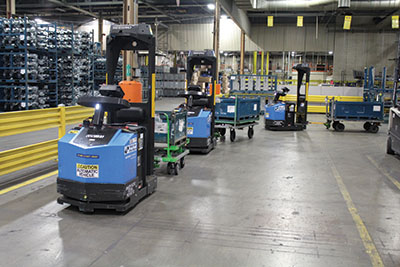General Motors operates hundreds of manufacturing facilities across the world and produces millions of vehicles annually. GM’s Detroit-Hamtramck plant—one of its most complex manufacturing assembly facilities—employs about 1,800 workers in its 4.1-million-square-foot warehouse. In search of a flexible solution to increase throughput and optimize workflow, the company deployed industrial self-driving vehicles that improved efficiency and productivity.
Currently, more than 75 automated vehicles (Seegrid) operate within the facility. The vehicles move materials throughout the plant, primarily delivering bulk body shop and general-assembly materials. Relying exclusively on cameras for navigation, the vehicles create a 360-degree map of the facility when in route training. As the vehicles navigate, they use the stored images to compare with their current surroundings to avoid unexpected obstacles.
The navigation system allows the self-driving vehicles to be more consistent, predictable and reliable than human drivers, which improves efficiency and allows GM’s manufacturing process to be as productive as possible. Employees who once performed repetitive, lower-skilled work are now reallocated to positions that add more value to the company. The self-driving, vision-guided vehicles also operate seamlessly alongside human workers.
To manage their autonomous vehicles, GM uses the supplier’s fleet management tool, which provides real-time data about each vehicle. The tool is also integrated with the company’s manufacturing systems for a seamless workflow.
Remarketing manager Pasquale Forletta oversaw the implementation and deployment of the vehicles in his former role as industrial engineering manager at the plant.
“GM Manufacturing is laser focused on safety and waste elimination through continuous improvement,” Forletta says. “This technology helps us meet and exceed our objectives. They have brought a level of consistency that is unmatched through traditional materials handling operations. The reduced travel waste for long hauls across our giant facility was a huge selling point and they are very flexible and easy to train when things change.”
With reductions in waste, significant improvements to takt time, and increased throughput, GM has successfully achieved return on investment and is in talks to expand the use of the vehicles to other GM plants.
Article topics








